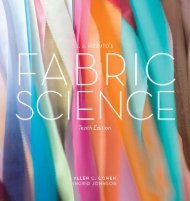Visual Merchandising Display - Fairchild Books
Visual Merchandising Display - Fairchild Books
Visual Merchandising Display - Fairchild Books
Create successful ePaper yourself
Turn your PDF publications into a flip-book with our unique Google optimized e-Paper software.
Figure 4.6 Rows of round bulbs are lined up over the runway in the<br />
center of this women’s shop and, along with some recessed floods<br />
in the cut out circles in the dropped ceiling panel, serve as the<br />
primary light source. The spotlights, on tracks that run from the front<br />
to the rear of the store, highlight and accentuate the merchandise<br />
display on or off of the wall. Lime, Toronto. Design: GHA Design<br />
Studios, Montreal.<br />
Figure 4.7 The trend toward blacked out or very dark retail spaces<br />
accented only by sharp, bright spots of light is illustrated here. The<br />
lighting is almost all accent lighting, with the light on the product and<br />
none on the setting. Metal halides are used almost exclusively, except<br />
for the fluorescent tubes used to wash the walls of the recessed<br />
areas. Levi’s, Berlin. Design: Checkland Kindleysides, London.<br />
38<br />
P a r t 1 : G e t t i n G S ta r t e d — V i S u a l M e r c h a n d i S i n G a n d d i S P l ay B a S i c S<br />
Floodlights are also incandescent bulbs, but they usually<br />
have frosted glass envelopes, or enclosures, and are less<br />
concentrated, having a wider beam spread than spotlights.<br />
Incandescent bulbs can be set into recessed high-hat<br />
fixtures in the ceiling, clustered in chandeliers, or hung as<br />
droplights. They can be mounted into housings that ride<br />
back and forth on ceiling tracks and can be directed, or<br />
focused, on merchandise or displays. Bare bulbs, silverbottomed<br />
bulbs, 5-inch globelike bulbs, or tiny, round<br />
complexion bulbs can be decoratively lined up, clustered, or<br />
“polka dotted” on the ceiling to please the eye, add charm<br />
to the design scheme, and “stroke” the merchandise. (See<br />
Figures 4.6–4.8.)<br />
High-Intensity Discharge (HID)<br />
Lighting<br />
The HID lamp, which is very energy efficient, is becoming<br />
a strong contender in the field of general, overall store<br />
lighting, in some cases replacing the fluorescent with its<br />
long and readily apparent fixtures. HIDs are relatively<br />
small in size (compared with fluorescent lamps) and will,<br />
like incandescents, provide shadows and highlights.<br />
The mercury-type HID may be too green, the metalhalide-type<br />
may appear too blue, and the sodium type is<br />
quite yellow, but new developments are producing warmer<br />
and more flattering types of light. General Electric’s Multi-<br />
Vapor is an improved metal-halide-type lamp that produces<br />
a light similar to a standard coolwhite fluorescent, which is<br />
satisfactory in some areas. It is still cooler and bluer than an<br />
incandescent lamp, however. Ceramalux has a high-pressure<br />
sodium lamp (HPS), which works well at the warm<br />
end of the color wheel, but it is still yellower than an incandescent<br />
lamp.<br />
Incandescent spotlighting can be used to accent and<br />
highlight with HID overall lighting but may require colored<br />
filters (like a pale, “daylite” filter) to go with a MultiVapor<br />
arrangement so that the different types of light do not jar<br />
each other. The Ceramalux provides a warm ambience and<br />
mixes well with warm white deluxe fluorescent or with<br />
regular incandescent. However, because HID lamps do













